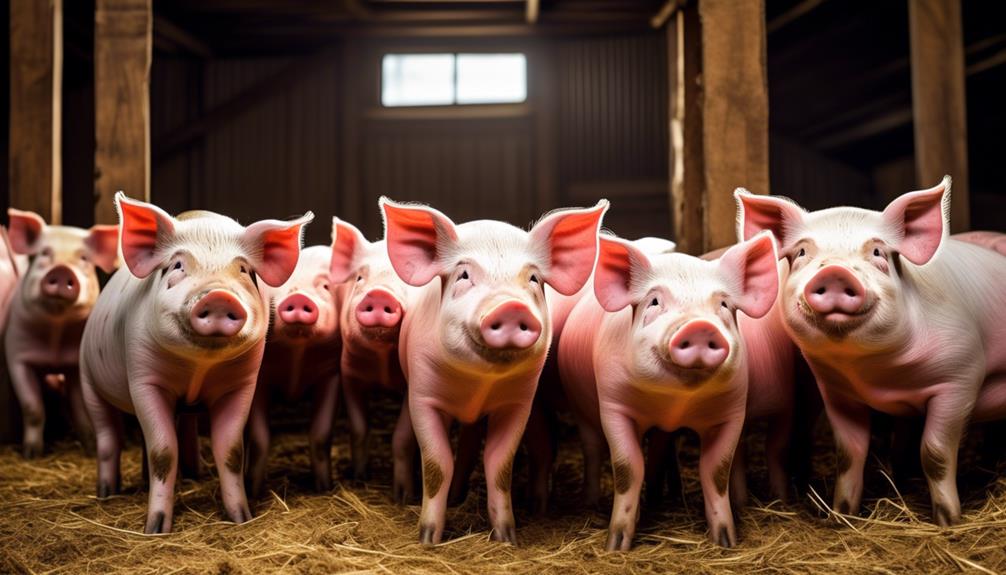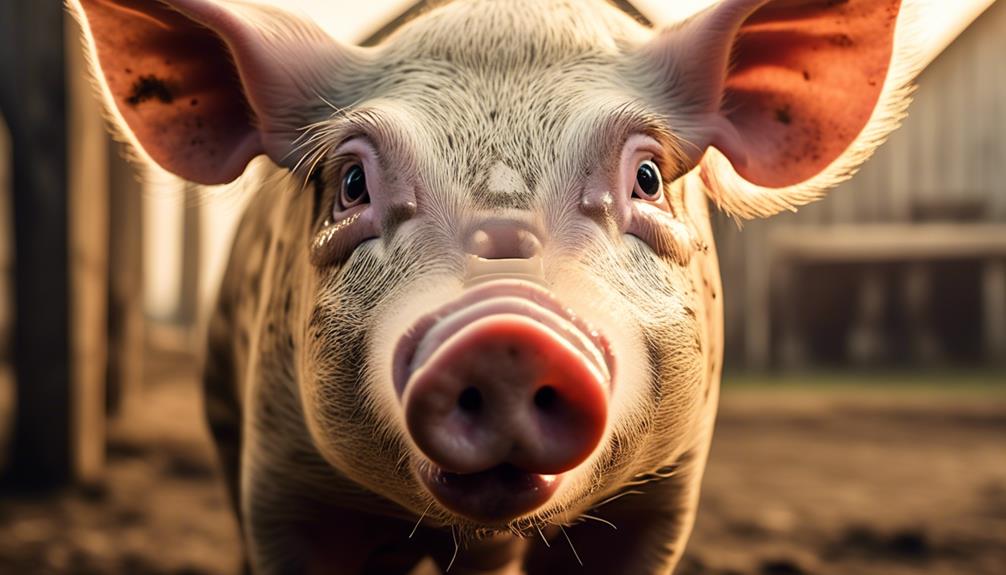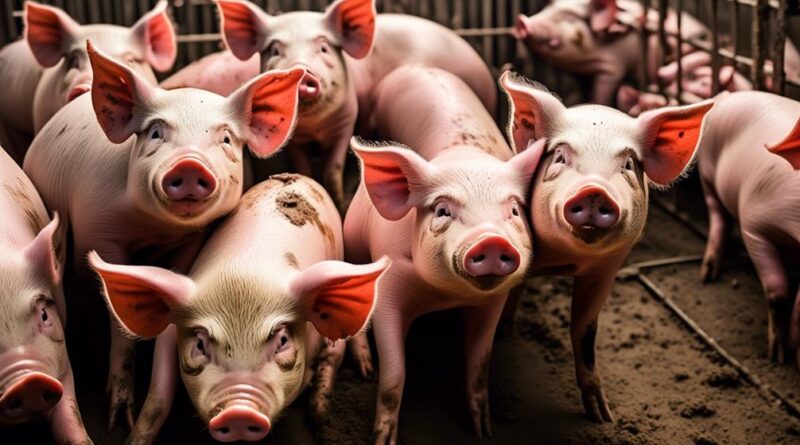5 Key Indicators of Stress in Pigs
You've probably heard the saying, 'stressed as a pig in a pen,' and there's some truth to that. Just like humans, pigs experience stress, and it can have a significant impact on their health and well-being.
But how can you tell if a pig is stressed? There are key indicators to look out for, and understanding these signs can help you ensure the welfare of your pigs.
By being able to recognize these indicators, you can take proactive steps to address and mitigate stress in your swine.
Changes in Eating Habits
If your pigs suddenly start eating less or more than usual, it could be an indication of stress. Weight loss and food aversion are common signs that your pigs might be experiencing stress. When pigs are stressed, their eating habits can change drastically. If you notice that your pigs are eating significantly less than usual, it's essential to investigate the potential causes of stress in their environment. Pigs may also show aversion to certain foods they previously enjoyed, which is another indicator of stress. It's crucial to observe their behavior and monitor their food intake to ensure their well-being.
Weight loss in pigs can be a concerning sign of stress. If you notice a sudden and unexplained drop in their weight, it's important to take immediate action to address the underlying stressors. Stress can suppress the appetite of pigs, leading to reduced food consumption and subsequent weight loss. Additionally, food aversion, where pigs avoid certain types of food, can be linked to stress-induced changes in their behavior.
To address these eating habit changes, it's important to evaluate the pigs' living conditions, social dynamics, and any recent changes in their environment. Providing a stress-free and comfortable environment, as well as maintaining a consistent and balanced diet, can help alleviate their stress and restore their regular eating habits. Monitoring their weight and food intake regularly can help identify any issues early on and prevent further complications.
Aggressive Behavior
Pigs may exhibit aggressive behavior when experiencing stress, which can manifest in various forms such as biting, chasing, or vocalizing with hostility. Aggressive behavior is a key indicator of stress in pigs and should be carefully monitored to ensure the well-being of the animals. When pigs are under stress, they may display aggressive tendencies towards other pigs, handlers, or even inanimate objects within their environment. This behavior can result in injuries to themselves or others, making it crucial to identify and address the underlying stressors.
One common form of aggressive behavior in pigs is biting. When stressed, pigs may resort to biting as a way to express their discomfort or frustration. Additionally, they may engage in chasing behaviors, aggressively pursuing other pigs or even humans within their vicinity. This can pose a significant risk to the safety of both the pigs and those caring for them. Furthermore, pigs may vocalize with hostility, expressing their stress through aggressive grunting, squealing, or other vocalizations that indicate distress.
It is essential for pig farmers and handlers to be vigilant for signs of aggressive behavior, as it can provide valuable insights into the mental and emotional state of the animals. By recognizing aggressive behavior as a potential indicator of stress, proactive measures can be taken to address the underlying issues and promote the well-being of the pigs in their care.
Social Withdrawal

Social withdrawal in pigs can be a clear indication of underlying stress and should be carefully observed by handlers and farmers. When pigs display isolation behavior, such as avoiding interaction with pen mates, it's often a sign of distress. Pigs are social animals, and their withdrawal from social interactions can signal loneliness and unease. As a handler or farmer, it's crucial to recognize these signs and take appropriate measures to address the issue.
Isolation behavior in pigs can manifest in various ways, including staying away from other pigs, reduced vocalization, and spending more time alone. These behaviors can have a significant impact on the well-being of the animals. Pigs that experience social withdrawal may exhibit decreased appetite, lethargy, and reduced interest in their surroundings. Additionally, loneliness can impact their overall health and immune function, making them more susceptible to diseases.
It is essential to closely monitor the social dynamics within pig groups and identify any potential triggers for social withdrawal. Stressors such as overcrowding, changes in group composition, or environmental disturbances can contribute to this behavior. By addressing these factors and providing a comfortable and enriching environment, handlers and farmers can help alleviate loneliness impact and reduce social withdrawal in pigs.
Excessive Scratching or Itching
Experiencing excessive scratching or itching can indicate discomfort and potential skin issues in pigs, warranting careful observation and appropriate action by handlers and farmers.
Itch behavior is a key indicator of stress or discomfort in pigs. When pigs excessively scratch or itch themselves, it may suggest that they're experiencing skin irritation or parasitic infestations.
Skin irritation can lead to open sores or wounds, making pigs more susceptible to infections. If left unaddressed, excessive scratching can lead to self-inflicted injuries, further exacerbating the pigs' discomfort and compromising their overall welfare.
It is essential to address excessive scratching or itching promptly to ensure the well-being of the pigs. Farmers and handlers should closely monitor the pigs for signs of itch behavior and identify the underlying cause, which could range from external parasites to allergies or environmental factors.
Additionally, maintaining clean and hygienic living conditions can help prevent skin irritation and reduce the likelihood of itch behavior among pigs. Regular veterinary care and inspections are crucial to promptly address any skin issues and prevent them from escalating.
Restlessness or Agitation
Address signs of restlessness or agitation in your pigs promptly to ensure their well-being and minimize stress. Behavioral signs such as pacing, excessive vocalization, or aggressive behavior can indicate that your pigs are experiencing stress. Restlessness or agitation can be brought on by various factors including environmental changes, overcrowding, or lack of stimulation. It's crucial to address these signs promptly to prevent further escalation of stress and potential health issues in your pigs.
To effectively manage stress-related restlessness or agitation, it's essential to identify and address the underlying causes. Ensure that your pigs have enough space to move around comfortably and access to enriching materials such as straw or toys to alleviate boredom. Regularly observe your pigs' behavior and make adjustments to their environment as needed to promote their well-being. Additionally, consider providing a balanced diet and maintaining a consistent routine to minimize potential stressors.
Stress management plays a significant role in preventing restlessness or agitation in pigs. By creating a low-stress environment and implementing appropriate enrichment strategies, you can help your pigs feel more secure and content. It's important to monitor your pigs closely and seek veterinary advice if behavioral signs of restlessness persist, as they could indicate underlying health issues.
Proactive stress management is key to maintaining the welfare of your pigs and ensuring their overall health and happiness.
Repetitive Movements
Staying attuned to your pigs' behavior, watch for repetitive movements as these may signal discomfort or stress, potentially stemming from factors such as environmental changes or lack of stimulation. Recognizing and addressing these signs early can contribute to the overall well-being of your pigs.
Here's what to look for:
- Stereotypic behavior: Keep an eye out for repetitive actions such as bar-biting, head weaving, or pacing. These behaviors are often indicative of stress or frustration, and may be a sign that your pigs aren't receiving adequate mental or physical stimulation.
- Management: Assess the overall management of your pig housing. If the environment is monotonous or lacks opportunities for natural foraging, exploration, or play, pigs may resort to repetitive movements as a way of coping with the lack of stimulation. Consider implementing environmental enrichment strategies to promote natural behaviors and enhance their welfare.
- Environmental enrichment: Evaluate the environmental enrichment provided to your pigs. Enrichment can include items such as straw, rooting materials, or hanging objects that encourage exploration and manipulation. Enrichment contributes to reducing stereotypic behaviors and promotes positive welfare outcomes for pigs.
Vocalization Changes

Monitoring the frequency and pitch of your pigs' vocalizations can provide valuable insights into their emotional state and overall well-being. Changes in vocalization frequency and pitch can indicate stress or discomfort in pigs. An increase in vocalization frequency, coupled with higher pitch, may suggest anxiety or pain. Conversely, a decrease in vocalization frequency and lower pitch can also be indicative of distress or illness. Therefore, paying attention to these vocalization cues can help you better understand your pigs' needs and address any potential issues promptly.
In addition to vocalization frequency and pitch, observing changes in vocalization duration and intensity is equally important. Prolonged or excessively intense vocalizations can signify acute distress, fear, or suffering in pigs. Conversely, unusually subdued vocalizations or a sudden reduction in vocalization duration may indicate depression or illness. By being attuned to these variations in vocalization, you can take proactive measures to alleviate stress and ensure the well-being of your pigs.
Reduced or Excessive Activity
Noticing changes in your pigs' vocalization patterns can also lead you to observe their activity levels, which can be indicative of their stress levels. Behavioral changes such as reduced or excessive activity in pigs can have significant welfare implications. Monitoring these activity levels is crucial for early detection of stress, allowing for timely intervention strategies.
- Reduced Activity: If you notice that your pigs are less active than usual, such as spending more time lying down and showing disinterest in their surroundings, it could be a sign of stress. Reduced activity may indicate discomfort, illness, or environmental stressors. It's essential to monitor and investigate the potential causes to address any underlying issues promptly.
- Excessive Activity: On the other hand, excessive activity, such as increased restlessness, pacing, or abnormal repetitive behaviors, can also signal stress in pigs. This behavior may be a coping mechanism or an attempt to alleviate discomfort. It's crucial to observe and assess the environment and social dynamics to identify and mitigate stressors that may be contributing to this behavior.
- Monitoring and Intervention Strategies: Regularly monitoring your pigs' activity levels, either through direct observation or technological means, can provide valuable insights into their well-being. Implementing enrichment activities, improving housing conditions, and ensuring proper nutrition and healthcare are crucial intervention strategies to address any behavioral changes and promote positive welfare outcomes for your pigs.
Frequently Asked Questions
What Are the Common Causes of Stress in Pigs?
Common causes of stress in pigs include overcrowding, temperature fluctuations, and social hierarchy issues. Behavioral signs like aggression and restlessness can impact productivity. Hormonal changes may also occur, affecting overall health and well-being.
How Can Stress in Pigs Affect Their Overall Health and Well-Being?
Stress in pigs can affect their overall health and well-being by impacting their immune system and causing behavioral changes. Effective stress management is essential to maintain their health and ensure their well-being.
Are There Any Specific Environmental Factors That Can Contribute to Stress in Pigs?
Specific environmental factors, such as temperature fluctuations and social dynamics, can contribute to stress in pigs. These factors can manifest through various stress indicators like vocalization, increased aggression, and decreased feed intake.
What Are Some Effective Strategies for Managing and Reducing Stress in Pig Populations?
To manage and reduce stress in pig populations, focus on nutritional management and behavioral enrichment. Providing a balanced diet and enriching their environment with toys and social interaction can help alleviate stress and promote their well-being.
Can Stress in Pigs Have an Impact on Their Reproductive Performance?
Yes, stress in pigs can significantly impact their reproductive performance. It affects fertility and can lead to decreased piglet survival rates. Managing and reducing stress in pig populations is crucial for maintaining healthy reproductive outcomes.
Conclusion
In conclusion, if you notice changes in a pig's eating habits, aggressive behavior, social withdrawal, excessive scratching or itching, restlessness, repetitive movements, vocalization changes, or reduced/excessive activity, it may be a sign of stress.
It's important to pay attention to these key indicators in order to address the source of stress and ensure the well-being of the pigs in your care.
